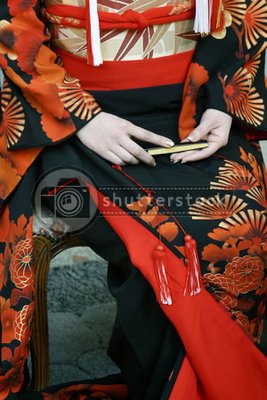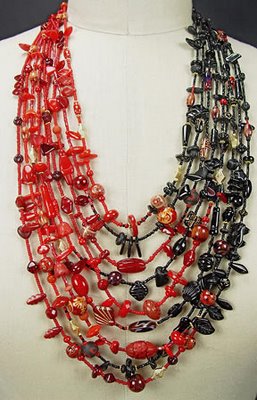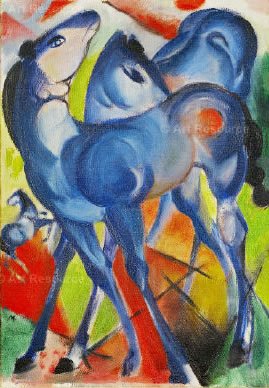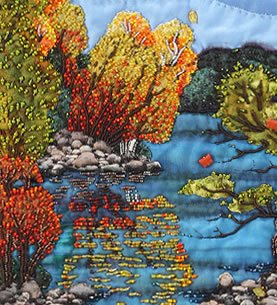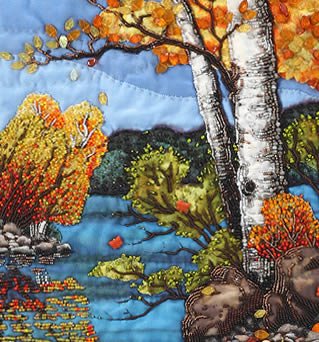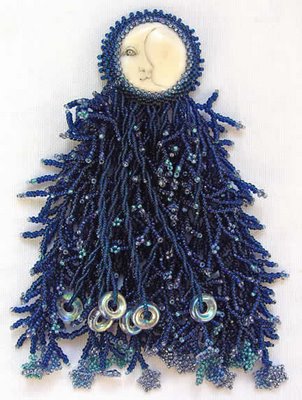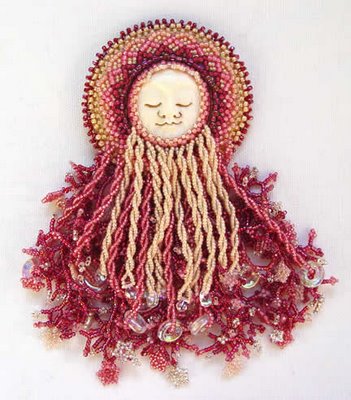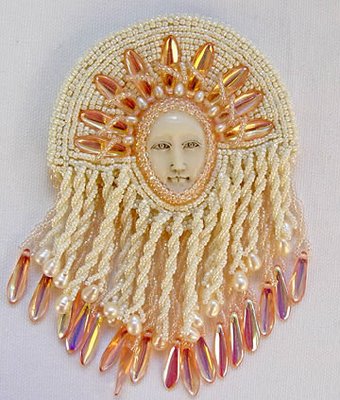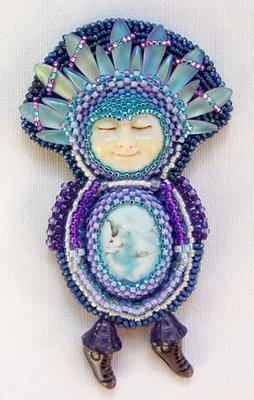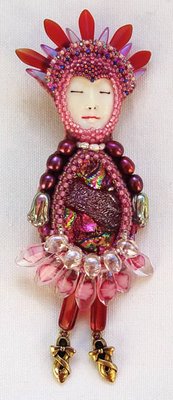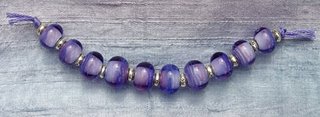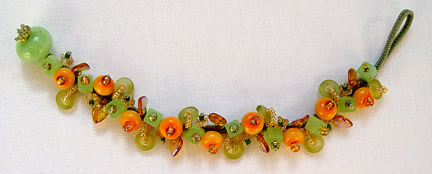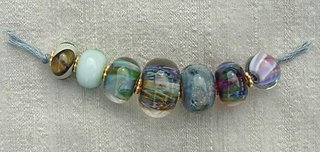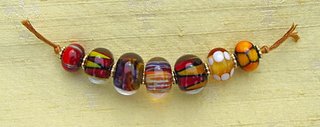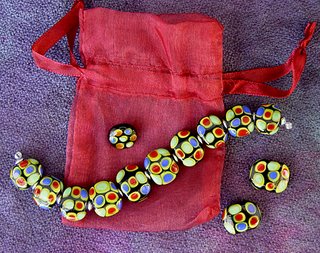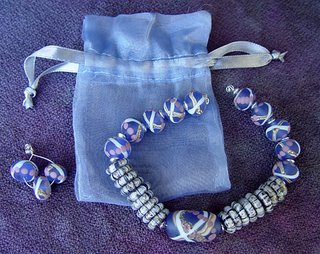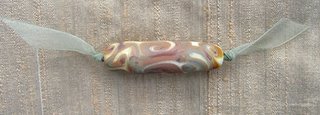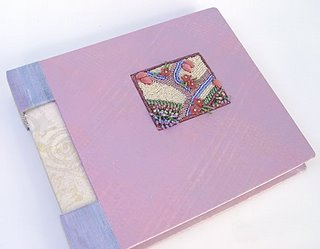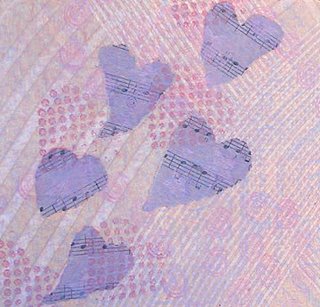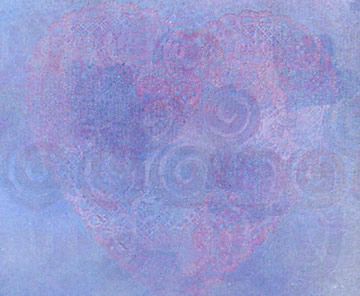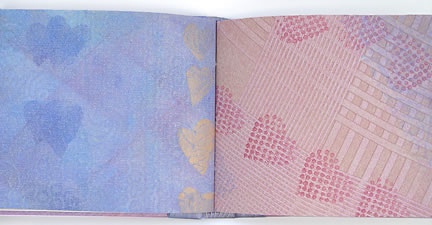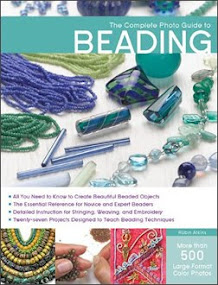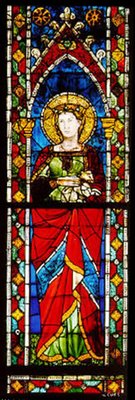   | Medieval Color Palette ~ It intrigues me to think that Medieval artists may have had that same consideration, wanting their windows to look spectacular from inside the church with the morning light shining through them, and also wanting them to look good to viewers standing outside the church. I wonder how many colors were available to them? Without professional lighting equipment, I found it difficult to photograph my stained glass tassel in a way that would show both the details in the black beads and, at the same time, the intense colors of the accent beads. But you can probably get the idea of it from this picture. Please visit tomorrow, for the last color palette in this series of posts. |
Sunday, July 30, 2006
Friday, July 28, 2006
Kimono-Inspired Necklace
Many of you know my bead embroidery work, and more recently spirit dolls and finger woven bracelets and necklaces. But way back in the dark ages, I started by making multiple strand necklaces, which I taught as a two-day class that included Japanese pearl knotting techniques and a 2-hour section on principles of design.
My favorite design technique was this: 1) Cut a smile or crescent shape out of a piece of typing paper. 2) Find a picture of a painting, piece of fabric, photograph or advertisement you really like. 3) Place the paper (the piece with the smile-shaped hole in it) over the picture, and move the paper around until you something jumps out as really wonderful. 4) Use this as a beading guide for colors - proportion, arrangement, scale - just copy what you see as best you can.
Several times, this method resulted in a gradual shift from one color on one side of the necklace to a different color on the other side of the necklace. I call it blending colors. And that's what I decided to do for my next Margie Deeb color study. (If you've just tuned in, see the previous two posts for news about Margie's forthcoming new book about color!)
My third challenge was to work with the color palette in the above picture of a Japanese kimono. In addition to making a piece to illustrate this palette, Margie wanted me to write step-by-step instructions for the project. Along with one hundred or more palettes and beaded examples of each, the book will include 20 projects with complete instructions. Since I haven't taught my multiple strand necklace class or blending methods for a long time, I decided to do the kimono in this technique!
Here is the finished necklace. I took photos of all the steps along the way, which will be in the book.
Stay tuned for more color studies! And, if any of you feel like it, give it a try. Look through a National Geographic or other magazine with color pictures, or a book of paintings, pick a picture you like a lot, and give yourself up to making something based on its color scheme. Beads are wonderful, yes - but you could do paper collage, a quilt block, a whole quilt, a doll - anything, as long as it's colors are based on the color scheme of the picture you've chosen.
Thursday, July 27, 2006
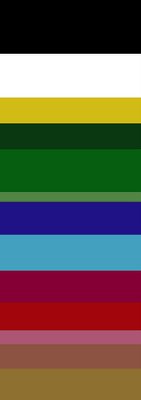 More Building Blocks ~
More Building Blocks ~ Color Theory
For Bead & Other Artists
If you are feeling stuck in a rut with your art, there's nothing like experimenting with colors to make it fun again. Even if you're not feeling stuck, playing with color, challenging yourself with color, can be exhilarating!
Such was the case for me 6 months ago when Margie Deeb asked me if I was interested in contributing any of my beadwork to her new book about color. Would I? You're darn tootin' I would!
One of Margie's ideas for the book is to take various famous paintings, abstract from them a proportional palette of colors (or hues) used by the artist, and create something new using the palette. My first assignment was a painting by Kandinsky (check out this or this). The palette is shown above, but because of copyright arrangements, I'm not allowed to show you the painting (although it will be in Margie's book). It's a little like this one.
Immediately, looking at a picture of Kandinsky's painting, I thought of JAZZ music, especially bluesy jazz. The notion came into my mind to make a bead embroidered pin about how much I love this type of music.
The first step was to gather beads which matched the palette. Kandinsky used a lot of colors, as you can see above ~ probably more than I could work into a "canvas" that would be less than 2 inches square. But it was really fun to go through my stash of seed and accent beads, selecting everything that closely matched the palette.
Once I was ready to start beading, I studied Kandinsky's work one more time, then put it away for the duration of the project. I didn't want to copy Kandinsky. Rather, I set as my goal: to capture the "feeling" of Kandinsky.
What made it most exciting was to work with an assortment of beads that I would not ordinarily choose on my own, and in a broader color range. What made it most challenging was the attempt to "say" something about both Kandinsky and my love of jazz in one tiny creation. Here is the finished work:
I call it All That Jazz, because it reminds me of both the movie and the song. Isn't it lucky that I happened to have these three blown glass jazz instruments? They've been in my stash for about 15 years, and I don't even remember where I got them. All in all, it was a most satisfying experience. So I invited Margie to give me another "assignment," which happily for me, she did. Please come back tomorrow for more.
The working title for Margie's new book is The Beader's Color Palette Book, but that could change as it goes into its final production stages. From what I have seen, it will offer many inspirational color palette ideas, each illustrated with examples made with different beading techniques and varying in complexity. Some of the palette ideas will also include step-by-step instructions for a project, one of which I'll show you in the next post. To get an idea of how Margie writes about color check this out, and be sure to scroll down far enough to get to the colors!
Wednesday, July 26, 2006
 New Ideas For
New Ideas For Working With Color!!!
I'm so excited about this, I can hardly stand it! I've just gotten permission to share a secret with you... and it's HUGE!
In 2004, Watson-Guptil publised a fabulously original book about color theory for beaders by Margie Deeb. It has been so popular that they've asked her to write more on the subject. After writing a book rated one of the top 20 beading books on the market (by Beads 2006), and being a substantial book (144 pages), one might think this was a somewhat daunting request. But not for Margie, who has seemingly unlimited ideas about how to get us jump-started with our colors.
Important: Margie's books about color are as much for non-beaders as they are for beaders. Read on and you will see what I mean.
Although Margie's new book doesn't have a firm release date yet, she's given me permission to show you some pictures from the book. For the next several posts, I will be giving you an EXCLUSIVE preview!
For the past 4 months I've been challenged to make beaded objects based on various color schemes which will be included in the new book. So far, I've made 10 pieces for it. Fun! Exciting! New! And very difficult to keep under my hat. I'll get to my work in the next few posts, but today I'm featuring work by Thom Atkins, my brother. Because of an injury, Thom gave up creating bronze sculptures some years ago, and got serious about quilting and beading... What fun it is to share my beady passion with a bro!
Margie gave Thom and interesting challenge. "Create something, perhaps a small beaded quilt or tapestry, based on the color palette in Blue Fillies, a painting by Marc Franz," she requested. Here's the painting, and above you can see the color palette she extracted from the painting.
And here is what Thom made! Notice how he kept the proportions and hues of color approximately the same as in the painting, yet the subject is entirely different. Whereas the painting is an example of expressionism, Thom's landscape is more realistic.
Here are some details from Thom's work. He uses beads to quilt, to add texture, and to add dimension. Congratulations, Thom! Well done!
Don't miss it... There will be more palettes and more beadwork in the next few posts!
Tuesday, July 25, 2006
Here are three more pieces by Tressie Hughes. This time, she has made The Royal Family Blackivory, each member featuring an ancient Orthoceras fossil as the body. She has used peyote stitch (an off-loom weaving technique) to fasten the fossils and carved bone faces to the surface (which I think is Ultrasuede) and to add the other details.
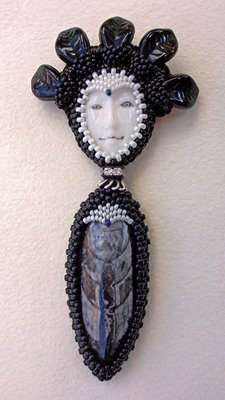
Lady Blackivory
Pin or Pendant by Tressie Huges
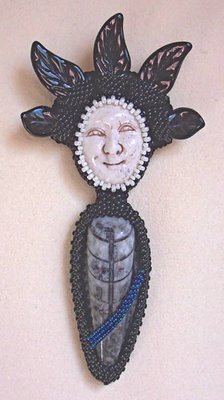
Lord Blackivory
Pin by Tressie Huges
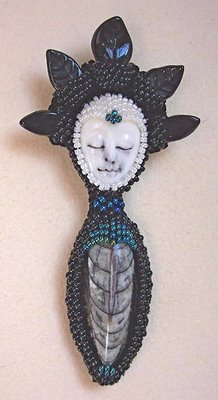
Prince Blackivory
Pin by Tressie Huges
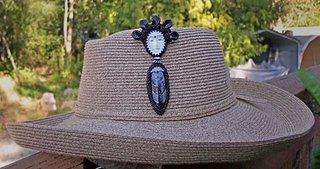
Shows pin worn as hat ornament.
If you'd like to contact her, you may email Tressie at
kc7bal -at- juno.com
Please substitute @ for -at- to make it work.
Sunday, July 23, 2006
and Fringes
And so, we will return to the Puget Sound Bead Festival, where I was privileged to see and photograph some fabulous beadwork. Today I'm going to bring you beadwork by Tressie Hughes.
two-piece pin by Tressie Hughes
Fringe detail
two-piece pin by Tressie Hughes
pin or pendant by Tressie Hughes
pin or pendant by Tressie Hughes
In case you're wondering, Tressie doesn't have a website. However, all of the pieces (except Blue Moon with Stars) are for sale ($85 to $200, depending on her time and materials cost). If you're interested, you can contact her by email: kc7bal-at-juno.com. (Be sure to substitute @ for -at-). Check in tomorrow to see Tressie's Royal Family!
Thanks, Tressie, for allowing me to take pictures of your work and share them with my blog readers!
Friday, July 21, 2006
D is for Dad...
D is for Dad, my wonderful Dad, who peacefully passed away last Thursday evening, two hours before I was able to get there (to St. Paul Minnesota, where my parents and two brothers live).
K is for kind and patient, which he always was with his five children. Yet he was not "soft," for he held us to high standards, both by his example and by his requirements of us.
H is for honest. I've never known a more honest and trustworthy person than my Dad
U is for unpretentious. Though he was a Phi Beta Kappa, PhD graduate of Stanford University, and a distinguished Professor at the University of MN for 37 years, he lived simply and modestly.
H is for his sense of humor and ready chuckle, the way he always made up funny words and songs, the way his spontaneous and contagious laugh would send adults and children into giggles and guffaws.
E is for even-tempered. Dad was a get along type of guy, optimistic, with a sunny disposition.
F is for friend. As I matured, our father-daughter relationship faded and morphed into a deep friendship, which flourished as Mom's hearing began to fail and finally was lost. Dad and I talked on the phone frequently, sometimes daily, often with long discussions on many diverse topics. I cannot imagine what it will be like not to have these telephone conversations any more.
L is for lost. This is how I feel at the moment.
L is also for love. Our love is with him and surrounds him, wherever he is... and his love is with us and surrounds us, wherever we are.
M is for how much I miss him... more than I can express.
T is for thank you. Thank you for the kind thoughts and wishes many of you posted to comments a week ago. They were a support and comfort to me.
Wednesday, July 12, 2006
Sad news. My wonderful Dad, who has been under Hospice care now for a while, has taken a turn for the worse. So, tomorrow I'll be heading for St. Paul, where I'll stay for a week at least. It's a tough time for our family... brother in CA is having surgery tomorrow.
I'll have access to a computer in MN, so I might do a post or two (without pictures). Will just have to see how it goes. Please check back from time to time...
&
Treasure Bracelets
So we continue yesterday's post with a look at some of Nicole LeClaire Brown's beautiful lampworked beads.
This carmel/peach set will make a fabulous bracelet. Of course they could be strung with accent beads between them, and that would be nice. But I think they'll look scrumptious in a woven treasure bracelet. Below is one of Nicole's bracelets (she's taken my class twice - once at the Coupeville Art Center, and again at the Bead Festival last week).
You can see how sweet these precious little beads look with just a few other complimentary beads, woven into a bracelet. Below is another set of Nicole's beads, which I plan to turn into a purple/blue dream bracelet.
And here's the bracelet Nicole made during class last week. This one she made for her mom, Renee, who was also in the class. These colors are totally Renee!
The bead sets and bracelets above feature repetition of the same (or very similar) beads, which gives the bracelets a pleasing unity. It's also fun to bring less similar, but still related, beads into a design scheme. Below are two groups of beads I got from Nicole, which I selected from about 200 orphan beads - one of a kind, left overs from sets, experimental beads, etc. I simply chose ones that I really liked. When I got home, and started playing with them, they seemed to group themselves into three different sets. I could only get two of the images to upload... here they are:
To ~ Nicole and Terri (see Terri's beads in yesterday's post) ~ Thanks for letting me post pictures of your beads, and here's wishing you all the success in the world with your passion. You are both so very talented!
To ~ All Who Don't Make Lampwork Beads ~ I've tried it and it isn't easy. It requires good depth perception (which was a problem for me) to be able to tell where your bead is positioned within the flame of the torch... a tad too close to the source and your bead is burned, a bit too far away and the glass doesn't melt properly. It requires steady hands and a willingness to get very close to fire. The glass, tools and equipment are expensive (as in: comparable to a closet full of fabrics, top of the line sewing machines, and a full set of templates and cutting tools). For most, the learning curve spans years, with lots of cracked, lumpy, unattractive beads along the way, before they're able to produce the consistency needed for a set of beads such as Terri's Lagoon Relic (picture previous post). Lampworkers, I salute you!
Oh, here's a grand link! It's a site where lampworkers can post pictures of their beads. They are currently showing the work of 1,809 glass artists. Here's Nicole's page.
To ~ Those of you who'd like to give finger weaving a try ~ this book (my newest baby, born just 4 weeks ago) shows you everything I've learned and discovered in the past 15 years about making and designing finger woven treasure bracelets, necklaces, tassels and straps. It's a fun, versatile, easy to learn technique!
Tuesday, July 11, 2006
Lampwork Beads
&
Treasure Bracelets
Fourteen years ago, I wrote an article for Ornament Magazine about Patricia Frantz and the process of making lampwork beads. At that time, she was one of four people in this country who knew how to make beads in the flame of a torch. Since then the art has grown and flourished, until, like all things beady, there are dozens of lampwork beadmakers in every community, thousands nation-wide. If you want to see examples by the best of the best, take a look at this book.
Among the relative newcomers to the field of lampwork beadmaking, Terri Budrow-Nelson and Nicole LeClaire Brown are two of my favorites. If you have a few seconds, check out these two links. Terri sells her beads on eBay; Nicole sells hers through her website.
Below is a set of beads (which she calls Primary Retro) I recently got from Terri.
And here is the finger woven treasure bracelet I made with them last week as a demonstration project for 22 very eager students at the Puget Sound Bead Festival. Their bracelets (and two tassels made with the same technique) are fabulous! If you want to learn how to make beaded treasures with finger weaving, get this book.
Here's one more set of Terri's beads. She calls this one Lagoon Relic.
I'll be making a finger woven treasure necklace with this set... can't wait to get started! Of course, I'll post pictures.
Tomorrow, look for pictures of Nicole's beads and two of her finger woven treasure bracelets. Here's a hint of what's to come ~ one of Nicole's beautiful lampwork beads:
* * * * * *
Surprisingly (because there was sooooooo much eye candy and lots of beady friends), I missed blogging and reading your blogs while I was at the Bead Festival last week. As soon as I get around to going through several hundred pictures I took there, I'll be sharing some fabulous art with you!
Wednesday, July 05, 2006
Beadland, Here I come...
See you next week, when the new topic will be:
Sunday, July 02, 2006
Earlier posts (May 29 - June 9) this year covered hand-made books made by my students at Valley Ridge Art School. Today, I finally got around to taking pictures of the book that I made during those four days. This book will be a wedding present for a very dear young friend, who I met in Romania in 1988, when she was 11 years old. Tomorrow I'll mail it to Denmark (where she lives now). I'm hoping they'll want to use it as a guest book, an album for their wedding photos, or perhaps a journal for recording special moments in their life together.

